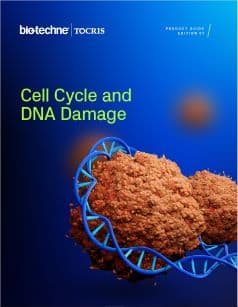ATM and ATR Kinases
ATM (Ataxia telangiectasia mutated) and ATR (Ataxia telangiectasia and Rad3 related) are closely related kinases that are activated by DNA damage. They are serine-threonine protein kinases which are part of the phosphatidylinositol 3' kinase-like kinase (PIKK) enzyme family.
ATM and ATR Kinase Inhibitors |
|
|---|---|
| Cat. No. | 产品名称/活性 |
| 5198 | AZ 20 |
| Potent and selective ATR kinase inhibitor; antitumor | |
| 6330 | AZ 5704 |
| Potent and selective ATM kinase inhibitor; orally bioavailable | |
| 3544 | KU 55933 |
| Potent and selective ATM kinase inhibitor | |
| 3190 | Mirin |
| MRN-ATM pathway inhibitor | |
ATM (Ataxia telangiectasia mutated) and ATR (Ataxia telangiectasia and Rad3 related) are closely related kinases that are activated by DNA damage. These serine-threonine protein kinases are part of the phosphatidylinositol 3' kinase-like kinase (PIKK) family.
Upon recruitment by the DNA damage binding proteins/complexes (ATRIP for ATR; MRN for ATM), ATM/ATR initiate the DNA damage checkpoint by phosphorylating a number of key proteins. Once activated, the checkpoint leads to cell cycle arrest and either DNA repair or apoptosis. ATM is activated by double stranded breaks and phosphorylates Chk2, whilst ATR is activated by single strand breaks and phosphorylates Chk1.
External sources of pharmacological information for ATM and ATR Kinases :
Literature for ATM and ATR Kinases
Tocris offers the following scientific literature for ATM and ATR Kinases to showcase our products. We invite you to request* your copy today!
*Please note that Tocris will only send literature to established scientific business / institute addresses.
Cell Cycle and DNA Damage Research Product Guide
This product guide provides a review of the cell cycle and DNA damage research area and lists over 150 products, including research tools for:
- Cell Cycle and Mitosis
- DNA Damage Repair
- Targeted Protein Degradation
- Ubiquitin Proteasome Pathway
- Chemotherapy Targets
Cell Cycle & DNA Damage Repair Poster
In normal cells, each stage of the cell cycle is tightly regulated, however in cancer cells many genes and proteins that are involved in the regulation of the cell cycle are mutated or over expressed. This poster summarizes the stages of the cell cycle and DNA repair. It also highlights strategies for enhancing replicative stress in cancer cells to force mitotic catastrophe and cell death.

